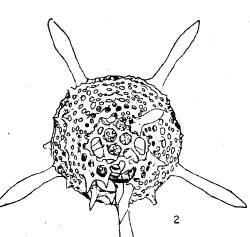|

|
|
Actinomma buspinigerum
(Hays, 1965)
|
Description - Add description
Actinomma buspinigerum n. sp. Hays 1965 p. 171, pi. 2, fig. 2.
Skeleton consists of four concentric shells, inner three thick-walled, their diameters in the constant ratio 1:3:7, pores of inner two circular equal in diameter to width of bars, pores of third shell large, rounded, usually irregular in size, 3-6 times bar width, 6-8 across equatorial diameter. Outer shell (fourth) thin-walled, smooth, variable in size, shape ranges from spheroidal to prunoidal, pores small, circular, of variable size, one-quarter to five times bar width, in some specimens set in polygonal depressions, usually evenly distributed over surface, but in some individuals the pores are clustered over the pores of the third shell. Innermost shell (first) connected to second shell by numerous radial beams that do not extend beyond second shell. Main spines originate at second shell, are long, circular in cross section, cylindrical
throughout most of their length, slightly inflated near distal end. Fourth shell supported not only by main spines but also by numerous beams arising from third shell and in some individuals extending through fourth shell to form short by-spines with triangular cross section.
Diameter of innermost shell 12-15, of second shell 35-43, of third shell 76-100, of fourth shell (major axis) 140-165, (minor axis) 130-155. Length of main spines in fully developed specimens 65—95. Description based on 55 individuals from samples V-16-57, 400, 440 cm; V-16-58, 1025, 1075 cm; V-16- 59, 280 cm; V-16-132, 280 cm. This species is distinguished from others of the genus by its prominent long cylindrical spines and the nearly spherical cortical shell. Prunopyle buspinigerum is probably closely related to three other species that occur in Antarctic cores: Actinomma imperfecta Popofsky [1908, p. 215], later redescribed by Riedel [1958, p. 224], Prunopyle antarctica Dreyer [1889, pp. 24-25], and Prunopyle tetrapila n. sp. (p. 172). All these species have in common the similar size and construction of the first three shells. They differ in the size and shape of the fourth shell and in the presence and type of spines they bear. P. tetrapila is a common constituent of zone ф and with rare exception lacks spines and has a large, heavy fourth shell. It extends upward across the diatomite red clay interface and disappears at about the point where P. buspinigerum first appears (Figures 22-27). In most of the cores that contain P. buspinigerum it is relatively short-lived and is replaced above by the two previously described species, Actinomma imperfecta Popofsky and Prunopyle antarctica Dreyer. These two species have spines that are short compared with those of P. buspinigerum and triangular in cross section. Their fourth shells are smaller than that of P. buspinigerum. It is tempting to suggest an evolutionary sequence from Prunopyle tetrapila to the two recent species P. antarctica and Actinomma imperfecta, but a considerable amount of additional work is necessary to determine the exact relationships between these four species. Prunopyle buspinigerum has not been observed in surface sediments from either north or south of the Polar Front. It occurs for short intervals in a number of cores (Figures 22—27) and in no case extends down to zone ф.
| | Hays 1965 |
|
|
 |

|